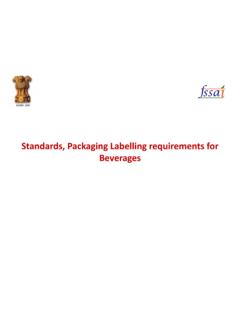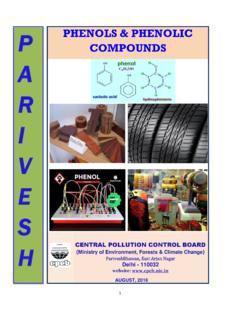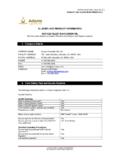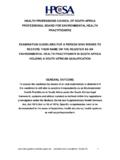Transcription of Guideline to regulations for radiopharmaceuticals in early ...
1 GUIDELINESG uideline to regulations for radiopharmaceuticals in earlyphase clinical trials in the EUAlfons Verbruggen&Heinz H. Coenen&Jean-Robert Deverre&Denis Guilloteau&Bengt Langstrom&Piero A. Salvadori&Christer Halldin#EANM 2008 AbstractThe purpose of this Guideline is to help inves-tigators by giving an overview of relevant current EUrequirements concerning the quality of starting materialsand final drug products (the radiopharmaceuticals ), the non-clinical safety studies and dosimetry considerations whilstdesigning a human clinical trial which includes the use ofradiopharmaceutical Europe, radiopharmaceutical compounds are considered aspecial group of medicines. Therefore, their preparation anduse are regulated by a number of EU directives, regulationsand rules that have been adopted by member states. The rateof adoption of directives varies between countries and eachmember state may introduce changes, provided the generalscope and limits of each directive are maintained.
2 Specificarticles have been set concerning radiopharmaceuticals thatare to receive marketing authorisation (MA) or are preparedstarting from licensed products (radionuclide generators,labelling kits and precursor radionuclides).However, radiopharmaceuticals may also be preparedoutside the MA track or used outside the indications theyhave been registered for. Small-scale preparations in bothindustrial sites (GMP licensed facilities) and non-industrialsites (hospital pharmacies, nuclear medicine departments,PET centres) indeed represent an important segment ofapplication. Although at this moment still non-bindingdocuments, the Guidelines on Good RadiopharmacyPractice (GRPP) issued by the Radiopharmacy Committeeof EANM [1] and the PIC/S guide to good practices forpreparation of medicinal products in healthcare establish-ments edited by the Pharmaceutical Inspection Convention/Pharmaceutical Inspection Co-operation Scheme [2]maybeuseful references for quality assurance into the small-scaleEur J Nucl Med Mol ImagingDOI the auspices of the Drug Development Committee of theEuropean Association of Nuclear Verbruggen (*)Laboratory of Radiopharmacy,Onderwijs en Navorsing 2, Box 821, Herestraat 49,3000 Leuven, Belgiume-mail: H.
3 CoenenInstitut f r Neurowissenschaften und BiophysikINB-4 (Nuklearchemie) Forschungszentrum J lich,52425 J lich, DeverreCEA Service Hospitalier Fr d ric Joliot,Orsay, FranceD. GuilloteauINSERM Unit 619 CHRU de Tours,Universit Fran ois-Rabelais de Tours,Tours, FranceB. LangstromRadiopharmaceutisk organisk kemi, UPPSALA UNIVERSITET,Institutionen f r biokemi och organisk kemi,Uppsala, SwedenP. A. SalvadoriRadiopharmaceutical Chemistry Department,CNR Institute of Clinical Physiology,Pisa, ItalyC. HalldinKarolinska Institutet, Department of Clinical Neuroscience,Stockholm, Swedenpreparation of radioactive pharmaceuticals and their non-radioactive situations may be faced with respect to thenature and intended application of radiopharmaceuticalswithin a clinical trial or depending on the fact whether therelevant product is or is not described in a monograph of apharmacopoeia or approved following a MA.
4 From apractical point of view the following situations might occur: Licensed radiopharmaceutical products used withintheir authorised indications, Licensed radiopharmaceutical products used outsidetheir authorised indications, radiopharmaceuticals having established clinical usethat are prepared in accordance with approved regu-lations and meet approved quality requirements ( asdescribed in a monograph of a pharmacopoeia), New radiopharmaceuticals or tracer agents outside theprevious must comply with different requirements as afunction of such a distinction and the application of goodclinical and/or pharmaceutical practice (GCP and GPP)standards, which may have been implemented at differentlevels in some European quality and safety during clinical trials are acrucial part of GCP. In the case of radioactive medicines,radiation burden (dosimetry) also deserves a carefulanalysis before any experimental trial is the EU, a clinical trial application (CTA) needs to besubmitted to the responsible national authority and theethical committee involved before any research in humansmay be started.
5 Such an application must include informationon any anticipated safety risk, based on results of pharma-cologic and toxicological data collected during studies of thedrug in animals and genotoxicity tests [3]. Quality assuranceduring the manufacturing of the medicine should bemaintained throughout the production phase and non-clinicalsafety studies should be adequate at any stage to characterisepotential adverse effects under the condition of the trial. Fordetails on the information to be provided in a CTA, see theEudralex documents Detailed guidance for the request forauthorisation of a clinical trial on a medicinal product forhuman use to the competent authorities [4]and Guidelineon the requirements to the chemical and pharmaceuticalquality documentation concerning investigational medicinalproducts in clinical trials [5].The present Guideline provides investigators with anoverview of EU requirements concerning quality of startingmaterials and finished drug products, non-clinical safetystudies and dosimetry considerations whilst designing ahuman clinical trial which includes the use of radiophar-maceutical compounds.
6 Where cited in this document, theEU regulations are written in italics. Most of the existingrules are, however, intended for medicinal products ingeneral and not specific for radiolabelled , some of the current regulations even do not takeinto account the special characteristics of radiopharmaceu-tical compounds, such as the short physical half-life of theradionuclide. However, it is not the goal of the presentguideline to propose at this stage more adapted rules whichcould facilitate early phase clinical studies with radio-pharmaceuticals, but to guide the reader through theextensive existing legislation. Proposals for more appro-priate regulations will be the subject of a follow-up paperfrom the Drug Development Committee of the EuropeanAssociation of Nuclear addition, it should be noted that this Guideline has nobinding value and must be considered as reference must consult their competent authority toverify specific national requirements and , this Guideline does refer only to radiopharma-ceuticals used in clinical trials for diagnostic procedures.
7 Onthe other hand, most of the regulations discussed are valid alsofor tracer agents without marketing authorisation used by aphysician, not in the framework of a clinical trial, but for adiagnosis in a patient ( ) on hisown responsibility, in the form of a magistral Guideline thus aims to provide useful legal informationfor the conduct of early phase clinical trials with radio-pharmaceuticals by summarising and explaining regulationsregarding: quality requirements for starting materials of radio-labelled drug substances (radiolabelled active ingre-dients), the starting material tetraacetyl mannosetriflate as a precursor of the drug substance18F-fluorodeoxyglucose, quality requirements for active ingredients of radiophar-maceuticals, medronic acid as an active ingredientof99mTc-MDP injection, quality requirements for radiopharmaceuticals , injection as the finished drugproduct, minimal range of toxicological data, dosimetry as described in Eudralex documents [6]and in the European Pharmacopoeia [7]Directivesare rules addressed by the EU commission to theMember States to be translated into the respective nationalEur J Nucl Med Mol Imaginglegislation and effectively implemented.
8 Directives not mandatory but recommendations forthe effective implementation of Directives by the mandatory in all countries,being directly applied without translation into the any medicinal productwhich, when ready for use, contains one or more radio-nuclides (radioactive isotopes) included for a productmeans a medicinal product which hasundergone all stages of production, including packaging inits final all operations of purchase ofmaterials and products, production, quality control, release,storage, distribution of medicinal products and the materialmeans any substance used in theproduction of a medicinal product, but excluding precursoris any radionuclide produced forthe radiolabelling of another substance prior to precursorcan be an active pharmaceuticalingredient or an API starting material .Anactive pharmaceutical ingredient(API; synonyms:active ingredient,drug substance,medicinal substance)isany substance or mixture of substances intended to be usedin the manufacture of a drug (medicinal) product and that,when used in the production of a drug, becomes an activeingredient of the drug product.
9 Such substances are intendedto furnish pharmacological activity or other direct effect inthe diagnosis, cure, mitigation, treatment or prevention ofdisease or to affect the structure and function of the respect to radiopharmaceutical preparations, a recentGuideline on radiopharmaceuticals states thatthe daughterradionuclide of a radionuclide generator is to be consideredas active pharmaceutical ingredient[8]. As a logicalconsequence, every radionuclide used in the manufacture ofa radiopharmaceutical without a purification of the finalpreparation before administration must be considered anAPI. The same Guideline states thatfor radiopharmaceuticalkits, the active ingredient is considered to be that part of theformulation that is intended to carry or bind the radio-nuclide or to permit its binding. Radioactive drug substancesare as a rule not isolated[8].AnAPI starting material(oractive substance startingmaterial) is a raw or intermediate material that is used inthe production of an API and that is incorporated as asignificant structural fragment into the structure of the API starting material can be a material purchased on themarket from one or more suppliers or produced by amanufacturer under a contract or a commercial agreementor produced the constituents of a pharmaceutical formapart from the active substance.
10 Excipients include, fillers,disintegrants, lubricants, colouring matters, antioxidants,preservatives, adjuvants, stabilisers, thickeners, emulsifiers,solubilisers, permeation enhancers, flavouring and aromaticsubstances, etc., and the constituents of the outer covering ofthe medicinal products, gelatine capsules [9].The terminvestigational radiopharmaceuticalfor earlyphase clinical trials refers to a radioactive pharmaceuticalform of a substance or placebo being tested or used as areference in a clinical trial, including products already with amarketing authorisation but used or assembled (formulatedor packaged) in a way different from the authorised form, orwhen used for an unauthorised indication, or when used togain further information about the authorised medicinal products(NIMPs) areproducts which are not the object of investigation ( than the tested product, placebo or active comparator)but which may be supplied to subjects participating in atrial and used in accordance with the protocol.












